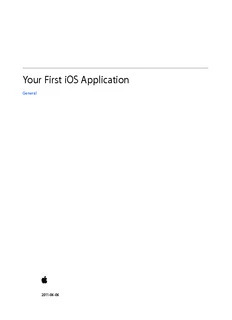
your first iPhone app tutorial (iOS App 101) PDF
Preview your first iPhone app tutorial (iOS App 101)
Your First iOS Application General 2011-06-06 Somestatesdonotallowtheexclusionorlimitation ofimpliedwarrantiesorliabilityforincidentalor AppleInc. consequentialdamages,sotheabovelimitationor ©2011AppleInc. exclusionmaynotapplytoyou.Thiswarrantygives youspecificlegalrights,andyoumayalsohave Allrightsreserved. otherrightswhichvaryfromstatetostate. Nopartofthispublicationmaybereproduced, storedinaretrievalsystem,ortransmitted,in anyformorbyanymeans,mechanical, electronic,photocopying,recording,or otherwise,withoutpriorwrittenpermissionof AppleInc.,withthefollowingexceptions:Any personisherebyauthorizedtostore documentationonasinglecomputerfor personaluseonlyandtoprintcopiesof documentationforpersonaluseprovidedthat thedocumentationcontainsApple’scopyright notice. TheApplelogoisatrademarkofAppleInc. Nolicenses,expressorimplied,aregranted withrespecttoanyofthetechnologydescribed inthisdocument.Appleretainsallintellectual propertyrightsassociatedwiththetechnology describedinthisdocument.Thisdocumentis intendedtoassistapplicationdevelopersto developapplicationsonlyforApple-labeled computers. AppleInc. 1InfiniteLoop Cupertino,CA95014 408-996-1010 AppStoreisaservicemarkofAppleInc. Apple,theApplelogo,Cocoa,CocoaTouch, Instruments,iPhone,Mac,Objective-C,and XcodearetrademarksofAppleInc.,registered intheUnitedStatesandothercountries. iPadisatrademarkofAppleInc. IOSisatrademarkorregisteredtrademarkof CiscointheU.S.andothercountriesandisused underlicense. EventhoughApplehasreviewedthisdocument, APPLEMAKESNOWARRANTYORREPRESENTATION, EITHEREXPRESSORIMPLIED,WITHRESPECTTO THISDOCUMENT,ITSQUALITY,ACCURACY, MERCHANTABILITY,ORFITNESSFORAPARTICULAR PURPOSE.ASARESULT,THISDOCUMENTIS PROVIDED“ASIS,”ANDYOU,THEREADER,ARE ASSUMINGTHEENTIRERISKASTOITSQUALITY ANDACCURACY. INNOEVENTWILLAPPLEBELIABLEFORDIRECT, INDIRECT,SPECIAL,INCIDENTAL,OR CONSEQUENTIALDAMAGESRESULTINGFROMANY DEFECTORINACCURACYINTHISDOCUMENT,even ifadvisedofthepossibilityofsuchdamages. THEWARRANTYANDREMEDIESSETFORTHABOVE AREEXCLUSIVEANDINLIEUOFALLOTHERS,ORAL ORWRITTEN,EXPRESSORIMPLIED.NoApple dealer,agent,oremployeeisauthorizedtomake anymodification,extension,oradditiontothis warranty. Contents Introduction Introduction 7 OrganizationofThisDocument 8 Chapter1 CreatingYourProject 11 Xcode 11 ApplicationBootstrapping 14 Recap 16 Chapter2 UnderstandingFundamentalDesignPatterns 17 Delegation 17 Model-View-Controller 17 Target-Action 18 OtherDesignPatterns 18 Chapter3 AddingaViewController 19 AddingaViewControllerClass 19 AddingaViewControllerProperty 22 CreatingtheViewControllerInstance 23 SettingUptheView 24 Housekeeping 25 ImplementationSourceListing 26 TesttheApplication 27 Recap 28 Chapter4 InspectingtheNibFile 29 AViewController’sViewOftenComesfromaNibFile 29 File’sOwner 30 TheViewOutlet 31 TesttheApplication 32 Recap 34 Chapter5 ConfiguringtheView 35 AddingtheUserInterfaceElements 35 MakeConnections 39 MaketheTextField’sDelegateConnection 43 Testing 44 3 2011-06-06 | © 2011 Apple Inc. All Rights Reserved. CONTENTS Recap 45 Chapter6 ImplementingtheViewController 47 TheUser’sNameProperty 47 ThechangeGreeting:Method 49 ConfiguretheViewControllerastheTextField’sDelegate 50 TesttheApplication 51 Recap 51 Chapter7 Troubleshooting 53 CodeandCompilerWarnings 53 ChecktheNibFiles 53 DelegateMethodNames 53 Chapter8 NextSteps 55 ImprovetheUserInterface 55 CreateUserInterfaceElementsProgrammatically 55 InstalltheApplicationonaDevice 56 AddMoreFunctionality 56 AddUnitTests 57 AppendixA CodeListings 59 HelloWorldAppDelegate 59 Theheaderfile:HelloWorldAppDelegate.h 59 Theimplementationfile:HelloWorldAppDelegate.m 59 MyViewController 60 Theheaderfile:MyViewController.h 60 Theimplementationfile:MyViewController.m 60 DocumentRevisionHistory 63 4 2011-06-06 | © 2011 Apple Inc. All Rights Reserved. Figures Chapter3 AddingaViewController 19 Figure3-1 MyViewController 20 Figure3-2 MyViewController 21 5 2011-06-06 | © 2011 Apple Inc. All Rights Reserved. FIGURES 6 2011-06-06 | © 2011 Apple Inc. All Rights Reserved. INTRODUCTION Introduction ThistutorialshowshowtocreateasimpleiOSapplication.Ithasatextfield,alabel,andabutton.Youcan typeyournameintothetextfieldandtapthebuttontosayhello.Theapplicationupdatesthelabel’stext tosay“Hello,<Name>!”: Thegoalisnottocreateafinelypolishedapplication,orontheotherhandtogetanapplicationonscreen asquicklyaspossible,buttoillustratetheThreeT’s: ● Tools:HowyoucreateandmanageaprojectusingXcode ● Technologies:Howtomakeyourapplicationrespondtouserinputusingstandarduserinterfacecontrols ● Techniques: The fundamental design patterns and techniques that underlie all Mac OS X development 7 2011-06-06 | © 2011 Apple Inc. All Rights Reserved. INTRODUCTION Introduction AsecondarygoalistopointoutotherdocumentsthatyoumustalsoreadtofullyunderstandtheiOS developmenttoolsandtechniques. YoushouldreadthisdocumentifyouarejuststartingdevelopmentforiOS.Youshouldusethistutorialto getstartedevenifyouintendtodevelopsolelyfortheiPad.AlthoughthetutorialshowstheiPhoneuser interface,thetoolsandtechniquesyouuseareexactlythesameasthoseyouusetodevelopiPadapplications. Youmust,though,alreadyhavesomefamiliaritywiththebasicsofcomputerprogrammingingeneraland theObjective-Clanguageinparticular.Ifyouhaven’tusedObjective-Cbefore,readthroughatleastLearning Objective-C:APrimer. Important: Tofollowthistutorial,youmusthaveinstalledtheiPhoneSDKanddevelopertoolsavailable fromtheiOSDevCenter. ThisdocumentdescribesthetoolsthatareavailableforiPhoneSDKv4.3andlater—checkthatyourversion ofXcodeisatleast4.0. TolearnmoreaboutthetechnologiesinCocoaTouch,readiOSTechnologyOverview. Inthistutorial,littleregardisgiventotheuserinterface.Presentationis,however,acriticalcomponentofa successfuliOSapplication.YoushouldreadtheiOSHumanInterfaceGuidelinestounderstandhowtheuser interfacemightbeimprovedforafull-fledgedapplication. Thistutorialdoesnotdiscussissuesbeyondbasicapplicationdevelopment;inparticular,itdoesnotdescribe howtosubmitapplicationstotheAppStore. Organization of This Document The tool you use to create Mac OS X applications is Xcode—Apple’s IDE (integrated development environment). “CreatingYourProject” (page 11)showsyouhowtocreateanewprojectanddescribeshowanapplication launches. WhereasXcodeistheapplicationyouusetocreateandmanagetheproject,Cocoa is the name given to the collection of APIs that you use to develop programs for Mac OS X. You should typically use the highest level of abstraction available to accomplish whatever task you want to perform. To create a desktop application, you should use the Objective-C-based frameworksthatprovidetheinfrastructureyouneedtoimplement graphical,event-drivenapplications. TousetheObjective-Cframeworkseffectively,youneedtofollowanumberofconventionsanddesign patterns.FollowingtheModel-View-Controller(or“MVC”)designpattern,theapplicationusesacontroller objecttomediatebetweentheuserinterface(viewobjects)andtheunderlyingrepresentationofatrack(a modelobject). ● “UnderstandingFundamentalDesignPatterns” (page 17)providesanoverviewofthedesignpatterns you’lluse. ● “AddingaViewController” (page 19)showsyouhowtocustomizeaviewcontrollerclassandcreatean instanceofit. Youdesigntheuserinterfacegraphically,usingXcode,ratherthanbywritingcode.Theinterfaceobjectsare storedinanarchivecalledanibfile. 8 OrganizationofThisDocument 2011-06-06 | © 2011 Apple Inc. All Rights Reserved. INTRODUCTION Introduction Terminology: Althoughaninterfacedocumentmayhavea“.xib”extension,historicallytheextensionwas “.nib”(anacronymfor“NextStepInterfaceBuilder”)sotheyarereferredtocolloquiallyas“Nibfiles.” Thenibfiledoesn’tjustdescribethelayoutofuserinterfaceelements,italsodefinesnon-userinterface elementsandconnectionsbetweenelements.Thecontrollerobjectisrepresentedinthenibfile.Atruntime, whenanibfileisloadedtheobjectsareunarchivedandrestoredtothestatetheywereinwhenyousaved thefile—includingalltheconnectionsbetweenthem. ● “InspectingtheNibFile” (page 29)introducesyoutotwoimportantconcepts:outlets,andtheFile’s Ownerproxyobject ● “ConfiguringtheView” (page 35)showsyouhowtoaddandconfigurethebuttonandtextfields. ● “ImplementingtheViewController” (page 47)walksyouthroughimplementingtheviewcontroller, includingmemorymanagement,thechangeGreeting:method,andensuringthatthekeyboardis dismissedwhentheusertapsDone ● “Troubleshooting” (page 53)describessomeapproachestosolvingcommonproblemsthatyoumay encounter. ● “NextSteps” (page 55)offerssuggestionsastowhatdirectionsyoushouldtakenextinlearningabout iOSdevelopment. OrganizationofThisDocument 9 2011-06-06 | © 2011 Apple Inc. All Rights Reserved. INTRODUCTION Introduction 10 OrganizationofThisDocument 2011-06-06 | © 2011 Apple Inc. All Rights Reserved.
Description: